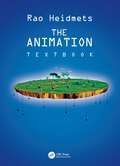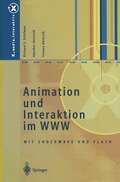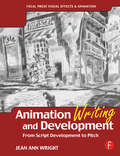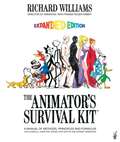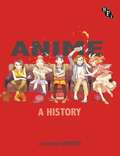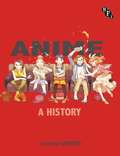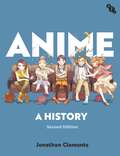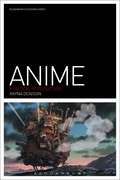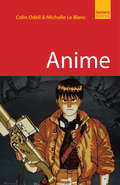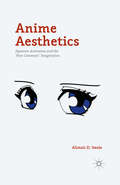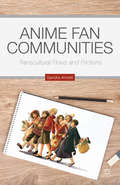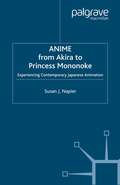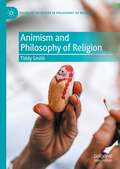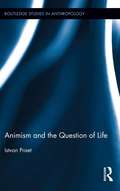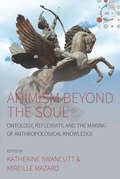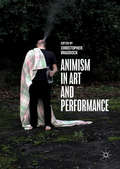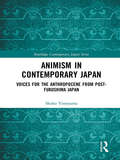- Table View
- List View
The Animation Textbook
by Rao HeidmetsThis introductory textbook provides practical exercises to help students and beginner animators get to grips with the basics of creating animated films. It covers both traditional 2D and 3D animated film, as well as experimental and computer animation. The first part of the book includes exercises colour-coded by difficult, to guide readers through the activities as they become more challenging. The second part of the book focuses on development, pre-production, production, and post-production to assist you with making your animated films feel more professional. The book also includes information and guidance on how to easily create animation using only a mobile phone. This book will be helpful to all students and newcomers looking to gain a grounding in the basics of animated film.
Animation und Interaktion im WWW: Mit Shockwave und Flash (X.media.interaktiv)
by Richard S. Schifman Günther Heinrich Yvonne HeinrichOhne professionellen Internet-Auftritt kein Erfolg im Netz! Der Praxis-Leitfaden beschreibt verständlich die Entwicklung animierter Webseiten mit Shockwave für Macromedia Director, Freehand, Audio und dem vectororientierten Animationsprogramm Flash. Fallbeispiele, Tips, Tricks und eine Arbeits-CD sorgen für Anschaulichkeit. Die Beispiele, PlugIns und Tools von der CD können für eigene Anwendungen übernommen werden.
Animation Writing and Development: From Script Development to Pitch
by Jean Ann WrightThe art. The craft. The business. Animation Writing and Development takes students and animation professionals alike through the process of creating original characters, developing a television series, feature, or multimedia project, and writing professional premises, outlines and scripts. It covers the process of developing presentation bibles and pitching original projects as well as ideas for episodes of shows already on the air. Animation Writing and Development includes chapters on animation history, on child development (writing for kids), and on storyboarding. It gives advice on marketing and finding work in the industry. It provides exercises for students as well as checklists for professionals polishing their craft. This is a guide to becoming a good writer as well as a successful one.
Animation Writing and Development: From Script Development to Pitch
by Jean Ann WrightThe art. The craft. The business. Animation Writing and Development takes students and animation professionals alike through the process of creating original characters, developing a television series, feature, or multimedia project, and writing professional premises, outlines and scripts. It covers the process of developing presentation bibles and pitching original projects as well as ideas for episodes of shows already on the air. Animation Writing and Development includes chapters on animation history, on child development (writing for kids), and on storyboarding. It gives advice on marketing and finding work in the industry. It provides exercises for students as well as checklists for professionals polishing their craft. This is a guide to becoming a good writer as well as a successful one.
The Animator’s Sketchbook: How to See, Interpret & Draw Like a Master Animator
by Tony WhiteThe Animator’s Sketchbook will teach students of animation how to improve their work through observation and drawing. It will show readers how to access their inner "animator." With over 60 different gesture and drawing exercises, this book enhances vision, analysis, understanding, and the core skills required to become a master animator. Filled with extensive practice pages, Tony White’s Sketchbook, invites students to demonstrate what they learn. Each exercise is timed, so that the skills acquired, are optimized for efficiency and comprehension. The style and technique of the art produced will be entirely up to the reader, thus making no two sketchbooks alike. Key Features Provides readers with their own personal sketchbook, demonstrating classical art skills that are highly prized by studio employers Readers will come away better visualizing form, gesture, pose and expression Includes 60 speed and gesture drawing exercises Provides the perfect way for students of animation to improve their core skills Perfect for animation instructors who can rely on this unique course workbook to take their students to new levels of classic visualizing expertise
The Animator’s Sketchbook: How to See, Interpret & Draw Like a Master Animator
by Tony WhiteThe Animator’s Sketchbook will teach students of animation how to improve their work through observation and drawing. It will show readers how to access their inner "animator." With over 60 different gesture and drawing exercises, this book enhances vision, analysis, understanding, and the core skills required to become a master animator. Filled with extensive practice pages, Tony White’s Sketchbook, invites students to demonstrate what they learn. Each exercise is timed, so that the skills acquired, are optimized for efficiency and comprehension. The style and technique of the art produced will be entirely up to the reader, thus making no two sketchbooks alike. Key Features Provides readers with their own personal sketchbook, demonstrating classical art skills that are highly prized by studio employers Readers will come away better visualizing form, gesture, pose and expression Includes 60 speed and gesture drawing exercises Provides the perfect way for students of animation to improve their core skills Perfect for animation instructors who can rely on this unique course workbook to take their students to new levels of classic visualizing expertise
The Animator's Survival Kit (PDF)
by Richard E. WilliamsAnimation is one of the hottest and most creative areas of film-making today . During his more than 40 years in the business, Richard Williams has been one of the true innovators, and serves as the link between the golden age of animation by hand and the new computer animation successes. In this book, based on his sold-out Animation Masterclass in the United States and across Europe, Williams provides the underlying principles of animation that very animator - from beginner to expert, classic animator to computer animation whiz - needs. Using hundreds of drawings, Williams distills the secrets of the masters into a working system in order to create a book that has become the standard work on all forms of animation for professionals, students and fans. This new expanded edition includes more on animal action, invention and realism with sophisticated animation examples
Anime: A History
by Jonathan ClementsThis comprehensive history of Japanese animation draws on Japanese primary sources and testimony from industry professionals to explore the production and reception of anime, from its early faltering steps, to the international successes of Spirited Away and Pokémon.
Anime: A History
by Jonathan ClementsThis comprehensive history of Japanese animation draws on Japanese primary sources and testimony from industry professionals to explore the production and reception of anime, from its origins in Japanese cartoons of the 1920s and 30s to the international successes of companies such as Studio Ghibli and Nintendo, films such as Spirited Away and video game characters such as Pokémon.
Anime: A History
by Jonathan ClementsJapanese animation is at the nexus of an international multimedia industry worth over $23.6 billion a year, linked to everything from manga to computer games, Pokémon and plushies. In this comprehensive guide, Jonathan Clements chronicles the production and reception history of the entire medium, from a handful of hobbyists in the 1910s to the Oscar-winning Spirited Away and beyond. Exploring the cultural and technological developments of the past century, Clements addresses how anime's history has been written by Japanese scholars, and covers previously neglected topics such as wartime instructional animation and work-for-hire for American clients. Founded on the testimonies of industry professionals, and drawing on a myriad of Japanese-language documents, memoirs and books, Anime: A History illuminates the anime business from the inside – investigating its innovators, its unsung heroes and its controversies. This new edition has been updated and revised throughout, with full colour illustrations and three new chapters on anime's fortunes among Chinese audiences and subcontractors, 21st century trends in 'otaku economics', and the huge transformations brought about by the rise of global streaming technology.
Anime: A History
by Jonathan ClementsJapanese animation is at the nexus of an international multimedia industry worth over $23.6 billion a year, linked to everything from manga to computer games, Pokémon and plushies. In this comprehensive guide, Jonathan Clements chronicles the production and reception history of the entire medium, from a handful of hobbyists in the 1910s to the Oscar-winning Spirited Away and beyond. Exploring the cultural and technological developments of the past century, Clements addresses how anime's history has been written by Japanese scholars, and covers previously neglected topics such as wartime instructional animation and work-for-hire for American clients. Founded on the testimonies of industry professionals, and drawing on a myriad of Japanese-language documents, memoirs and books, Anime: A History illuminates the anime business from the inside – investigating its innovators, its unsung heroes and its controversies. This new edition has been updated and revised throughout, with full colour illustrations and three new chapters on anime's fortunes among Chinese audiences and subcontractors, 21st century trends in 'otaku economics', and the huge transformations brought about by the rise of global streaming technology.
Anime: A Critical Introduction (Film Genres)
by Rayna DenisonAnime: A Critical Introduction maps the genres that have thrived within Japanese animation culture, and shows how a wide range of commentators have made sense of anime through discussions of its generic landscape. From the battling robots that define the mecha genre through to Studio Ghibli's dominant genre-brand of plucky shojo (young girl) characters, this book charts the rise of anime as a globally significant category of animation. It further thinks through the differences between anime's local and global genres: from the less-considered niches like nichijo-kei (everyday style anime) through to the global popularity of science fiction anime, this book tackles the tensions between the markets and audiences for anime texts. Anime is consequently understood in this book as a complex cultural phenomenon: not simply a "genre,†? but as an always shifting and changing set of texts. Its inherent changeability makes anime an ideal contender for global dissemination, as it can be easily re-edited, translated and then newly understood as it moves through the world's animation markets. As such, Anime: A Critical Introduction explores anime through a range of debates that have emerged around its key film texts, through discussions of animation and violence, through debates about the cyborg and through the differences between local and global understandings of anime products. Anime: A Critical Introduction uses these debates to frame a different kind of understanding of anime, one rooted in contexts, rather than just texts. In this way, Anime: A Critical Introduction works to create a space in which we can rethink the meanings of anime as it travels around the world.
Anime: A Critical Introduction (Film Genres)
by Rayna DenisonAnime: A Critical Introduction maps the genres that have thrived within Japanese animation culture, and shows how a wide range of commentators have made sense of anime through discussions of its generic landscape. From the battling robots that define the mecha genre through to Studio Ghibli's dominant genre-brand of plucky shojo (young girl) characters, this book charts the rise of anime as a globally significant category of animation. It further thinks through the differences between anime's local and global genres: from the less-considered niches like nichijo-kei (everyday style anime) through to the global popularity of science fiction anime, this book tackles the tensions between the markets and audiences for anime texts. Anime is consequently understood in this book as a complex cultural phenomenon: not simply a “genre,” but as an always shifting and changing set of texts. Its inherent changeability makes anime an ideal contender for global dissemination, as it can be easily re-edited, translated and then newly understood as it moves through the world's animation markets. As such, Anime: A Critical Introduction explores anime through a range of debates that have emerged around its key film texts, through discussions of animation and violence, through debates about the cyborg and through the differences between local and global understandings of anime products. Anime: A Critical Introduction uses these debates to frame a different kind of understanding of anime, one rooted in contexts, rather than just texts. In this way, Anime: A Critical Introduction works to create a space in which we can rethink the meanings of anime as it travels around the world.
Anime
by Colin Odell Michelle Le BlancThis guide to anime offers an overview of the art form, looking at its development in Japan and its export to other cultures. It includes a history of Japanese animation from early examples to the relaunch of animation as a viable commercial entity and its enormous rise in popularity after WWII. Anime explains the difference between manga and anime, offering a brief history of manga including its development from traditional art form (woodblock prints) to massive commercial success with millions of readers in Japan and worldwide. Odell and Le Blanc also consider anime style and genres, its market and importance in Japanese culture, and its perception in the West including controversy, such as criticisms of sex and violence in anime that affect other national markets, including the UK (notably Urotsukidoji) and the USA, where it is considered a 'kids only' market.
Anime Aesthetics: Japanese Animation and the 'Post-Cinematic' Imagination
by Alistair D. SwaleJapanese animation has been given fulsome academic commentary in recent years. However, there is arguably a need for a more philosophically consistent and theoretically integrated engagement. While this book covers the key thinkers of contemporary aesthetic theory, it aims to reground reflection on anime within the aesthetics of R.G. Collingwood.
Anime Fan Communities: Transcultural Flows and Frictions
by S. AnnettHow have animation fans in Japan, South Korea, the United States, and Canada formed communities and dealt with conflicts across cultural and geographic distance? This book traces animation fandom from its roots in early cinema audiences, through mid-century children's cartoon fan clubs, to today's digitally-networked transcultural fan cultures.
Anime from Akira to Princess Mononoke: Experiencing Contemporary Japanese Animation
by S. NapierWith the popularity of Pokemon still far from waning, Japanese animation, known as anime to its fans, has a firm hold on American pop culture. However, anime is much more than children's cartoons. It runs the gamut from historical epics to sci-fi sexual thrillers. Often dismissed as fanciful entertainment, anime is actually quite adept at portraying important social and cultural issues like alienation, gender inequality, and teenage angst. This book investigates the ways that anime presents these issues in an in-depth and sophisticated manner, uncovering the identity conflicts, fears over rapid technological advancement, and other key themes present in much of Japanese animation.
Animism and Philosophy of Religion (Palgrave Frontiers in Philosophy of Religion)
by Tiddy SmithMainstream philosophy of religion has persistently failed to engage seriously or critically with animist beliefs and practices. The field that is now called "philosophy of religion" could quite easily be renamed "philosophy of theism" with few lecturers on the subject having to change their lecture notes. It is the aim of this volume to rectify that failure and to present animism as a live option among the plethora of religious worldviews. The volume addresses four major questions: 1. What is this thing called "animism"? 2. Are there any arguments for or against animist belief and practice? 3. What is the relationship between animism, naturalism, and the sciences? And 4. Should we take animism seriously? Animism and Philosophy of Religion is intended to be the first authoritative scholarly volume on the issue of animism and its place in the philosophy of religion. Ambitiously, it aims to act as the cornerstone volume for future work on the subject and as a key text for courses engaging with the subject.
Animism and the Question of Life (Routledge Studies in Anthropology)
by Istvan PraetThe central purpose of this book is to help change the terms of the debate on animism, a classic theme in anthropology. It combines some of the finest ethnographic material currently available (including firsthand research on the Chachi of Ecuador) with an unusually broad geographic scope (the Americas, Asia, and Africa). Edward B. Tylor originally defined animism as the first phase in the development of religion. The heyday of cultural evolutionism may be over, but his basic conception is commonly assumed to remain valid in at least one respect: there is still a broad consensus that everything is alive within animism, or at least that more things are alive than a modern scientific observer would allow for (e.g., clouds, rivers, mountains) It is considered self-evident that animism is based on a kind of exaggeration: its adherents are presumed to impute life to this, that and the other in a remarkably generous manner. Against the prevailing consensus, this book argues that if animism has one outstanding feature, it is its peculiar restrictiveness. Animistic notions of life are astonishingly uniform across the globe, insofar as they are restricted rather than exaggerated. In the modern Western cosmology, life overlaps with the animate. Within animism, however, life is always conditional, and therefore tends to be limited to one’s kin, one’s pets and perhaps the plants in one’s garden. Thus it emerges that "our" modern biological concept of life is stranger than generally thought.
Animism and the Question of Life: Animism And The Question Of Life (Routledge Studies in Anthropology)
by Istvan PraetThe central purpose of this book is to help change the terms of the debate on animism, a classic theme in anthropology. It combines some of the finest ethnographic material currently available (including firsthand research on the Chachi of Ecuador) with an unusually broad geographic scope (the Americas, Asia, and Africa). Edward B. Tylor originally defined animism as the first phase in the development of religion. The heyday of cultural evolutionism may be over, but his basic conception is commonly assumed to remain valid in at least one respect: there is still a broad consensus that everything is alive within animism, or at least that more things are alive than a modern scientific observer would allow for (e.g., clouds, rivers, mountains) It is considered self-evident that animism is based on a kind of exaggeration: its adherents are presumed to impute life to this, that and the other in a remarkably generous manner. Against the prevailing consensus, this book argues that if animism has one outstanding feature, it is its peculiar restrictiveness. Animistic notions of life are astonishingly uniform across the globe, insofar as they are restricted rather than exaggerated. In the modern Western cosmology, life overlaps with the animate. Within animism, however, life is always conditional, and therefore tends to be limited to one’s kin, one’s pets and perhaps the plants in one’s garden. Thus it emerges that "our" modern biological concept of life is stranger than generally thought.
Animism beyond the Soul: Ontology, Reflexivity, and the Making of Anthropological Knowledge (Studies in Social Analysis #6)
by Katherine Swancutt and Mireille MazardHow might we envision animism through the lens of the ‘anthropology of anthropology’? The contributors to this volume offer compelling case studies that demonstrate how indigenous animistic practices, concepts, traditions, and ontologies are co-authored in highly reflexive ways by anthropologists and their interlocutors. They explore how native epistemologies, which inform anthropological notions during fieldwork, underpin the dialogues between researchers and their participants. In doing so, the contributors reveal ways in which indigenous thinkers might be influenced by anthropological concepts of the soul and, equally, how they might subtly or dramatically then transform those same concepts within anthropological theory.
Animism in Art and Performance
by Christopher BraddockThis book explores Māori indigenous and non-indigenous scholarship corresponding with the term ‘animism’. In addressing visual, media and performance art, it explores the dualisms of people and things, as well as 'who' or 'what' is credited with 'animacy'. It comprises a diverse array of essays divided into four sections: Indigenous Animacies, Atmospheric Animations, Animacy Hierarchies and Sensational Animisms. Cassandra Barnett discusses artists Terri Te Tau and Bridget Reweti and how personhood and hau (life breath) traverse art-taonga. Artist Natalie Robertson addresses kōrero (talk) with ancestors through photography. Janine Randerson and sound artist Rachel Shearer consider the sun as animate with mauri (life force), while Anna Gibb explores life in the algorithm. Rebecca Schneider and Amelia Jones discuss animacy in queered and raced formations. Stephen Zepke explores Deleuze and Guattari's animist hylozoism and Amelia Barikin examines a mineral ontology of art. This book will appeal to readers interested in indigenous and non-indigenous entanglements and those who seek different approaches to new materialism, the post-human and the anthropocene.
Animism in Art and Performance
by Christopher BraddockThis book explores Māori indigenous and non-indigenous scholarship corresponding with the term ‘animism’. In addressing visual, media and performance art, it explores the dualisms of people and things, as well as 'who' or 'what' is credited with 'animacy'. It comprises a diverse array of essays divided into four sections: Indigenous Animacies, Atmospheric Animations, Animacy Hierarchies and Sensational Animisms. Cassandra Barnett discusses artists Terri Te Tau and Bridget Reweti and how personhood and hau (life breath) traverse art-taonga. Artist Natalie Robertson addresses kōrero (talk) with ancestors through photography. Janine Randerson and sound artist Rachel Shearer consider the sun as animate with mauri (life force), while Anna Gibb explores life in the algorithm. Rebecca Schneider and Amelia Jones discuss animacy in queered and raced formations. Stephen Zepke explores Deleuze and Guattari's animist hylozoism and Amelia Barikin examines a mineral ontology of art. This book will appeal to readers interested in indigenous and non-indigenous entanglements and those who seek different approaches to new materialism, the post-human and the anthropocene.
Animism in Contemporary Japan: Voices for the Anthropocene from post-Fukushima Japan (Routledge Contemporary Japan Series)
by Shoko Yoneyama‘Postmodern animism’ first emerged in grassroots Japan in the aftermath of mercury poisoning in Minamata and the nuclear meltdown in Fukushima. Fusing critiques of modernity with intangible cultural heritages, it represents a philosophy of the life-world, where nature is a manifestation of a dynamic life force where all life is interconnected. This new animism, it is argued, could inspire a fundamental rethink of the human-nature relationship. The book explores this notion of animism through the lens of four prominent figures in Japan: animation film director Miyazaki Hayao, sociologist Tsurumi Kazuko, writer Ishimure Michiko, and Minamata fisherman-philosopher Ogata Masato. Taking a biographical approach, it illustrates how these individuals moved towards the conclusion that animism can help humanity survive modernity. It contributes to the Anthropocene discourse from a transcultural and transdisciplinary perspective, thus addressing themes of nature and spirituality, whilst also engaging with arguments from mainstream social sciences. Presenting a new perspective for a post-anthropocentric paradigm, Animism in Contemporary Japan will be useful to students and scholars of sociology, anthropology, philosophy and Japanese Studies.
Animism in Contemporary Japan: Voices for the Anthropocene from post-Fukushima Japan (Routledge Contemporary Japan Series)
by Shoko Yoneyama‘Postmodern animism’ first emerged in grassroots Japan in the aftermath of mercury poisoning in Minamata and the nuclear meltdown in Fukushima. Fusing critiques of modernity with intangible cultural heritages, it represents a philosophy of the life-world, where nature is a manifestation of a dynamic life force where all life is interconnected. This new animism, it is argued, could inspire a fundamental rethink of the human-nature relationship. The book explores this notion of animism through the lens of four prominent figures in Japan: animation film director Miyazaki Hayao, sociologist Tsurumi Kazuko, writer Ishimure Michiko, and Minamata fisherman-philosopher Ogata Masato. Taking a biographical approach, it illustrates how these individuals moved towards the conclusion that animism can help humanity survive modernity. It contributes to the Anthropocene discourse from a transcultural and transdisciplinary perspective, thus addressing themes of nature and spirituality, whilst also engaging with arguments from mainstream social sciences. Presenting a new perspective for a post-anthropocentric paradigm, Animism in Contemporary Japan will be useful to students and scholars of sociology, anthropology, philosophy and Japanese Studies.
